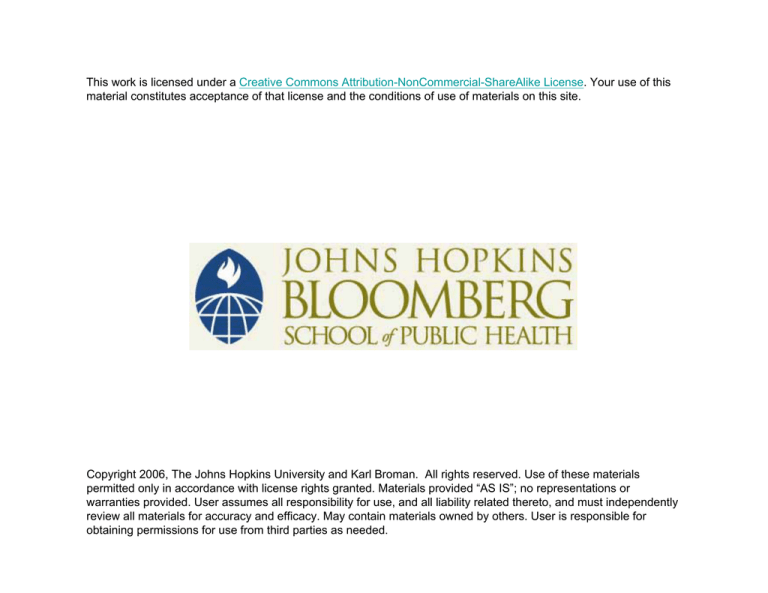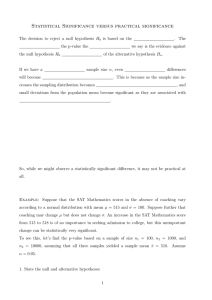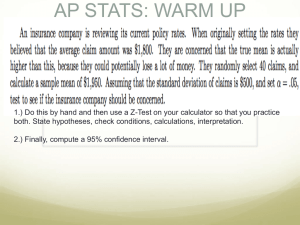
This work is licensed under a Creative Commons Attribution-NonCommercial-ShareAlike License. Your use of this
material constitutes acceptance of that license and the conditions of use of materials on this site.
Copyright 2006, The Johns Hopkins University and Karl Broman. All rights reserved. Use of these materials
permitted only in accordance with license rights granted. Materials provided “AS IS”; no representations or
warranties provided. User assumes all responsibility for use, and all liability related thereto, and must independently
review all materials for accuracy and efficacy. May contain materials owned by others. User is responsible for
obtaining permissions for use from third parties as needed.
Tests of hypotheses
Confidence interval:
Form an interval (on the basis of data)
of plausible values for a population parameter.
Test of hypothesis:
Answer a yes or no question regarding
a population parameter.
Examples:
• Do the two strains have the same average response?
• Is the concentration of substance X in the water supply above the safe limit?
• Does the treatment have an effect?
Example
We have a quantitative assay for the concentration of antibodies
against a certain virus in blood from a mouse.
We apply our assay to a set of ten mice before and after the injection of a vaccine. (This is called a “paired” experiment.)
Let X i denote the differences between the measurements (“after”
minus “before”) for mouse i.
We imagine that the X i are independent and identically distributed
normal(µ, σ ).
Does the vaccine have an effect?
In other words: Is µ 6= 0?
The data
16
4
15
after − before
after
14
13
2
0
12
11
−2
10
8
10
12
14
before
Hypothesis testing
We consider two hypotheses:
Null hypothesis, H0: µ = 0
Alt. hypothesis, Ha: µ 6= 0
Type I error: Reject H0 when it is true. (false positive)
Type II error: Fail to reject H0 when it is false. (false negative)
We set things up so that a Type I error is a worse error (and so
that we are seeking to prove the alternative hypothesis). We want
to control the rate (the significance level, α) of such errors.
√
Test statistic: T = (X̄ − 0)/(s/ 10)
We reject H0 if |T| > t?, where t? is chosen so that
Pr(Reject H0 | H0 is true) = Pr(|T| > t? | µ = 0) = α.
(generally α = 5%)
Example (continued)
Under H0 (i.e., when µ = 0),
√
T = (X̄ − 0)/(s/ 10) ∼ t(df = 9)
We reject H0 if |T| > 2.26.
t(df=9) distribution
2.5%
As a result, if H0 is true, there’s a 5%
chance that you’ll reject it.
−2.26
For the observed data:
X̄ = 1.93, s = 2.24, n = 10
√
T = (1.93 - 0) / (2.24/ 10) = 2.72
Thus we reject H0.
The goal
We seek to prove the alternative hypothesis.
We are happy if we reject H0.
In the case that we reject H0, we might say,
“Either H0 is false, or a rare event occurred.”
2.5%
2.26
Another example
Question: is the concentration of substance X in the water supply
above the safe level?
X 1, X 2, . . . , X 4 ∼ iid normal(µ, σ ).
Null hyp., H0: µ ≥ 6 (unsafe)
Alt. hyp., Ha: µ < 6 (safe)
Test statistic: T =
X̄ − 6
√
s/ 4
If we wish to have the significance
level α = 5%, the rejection region is
T < t? = –2.35.
t(df=3) distribution
5%
−2.35
One-tailed vs two-tailed tests
If you are trying to prove that a treatment improves things, you want a
one-tailed (or one-sided) test. (You’ll
reject H0 only if T < t?.)
t(df=3) distribution
5%
−2.35
If you are just looking for a difference, use a two-tailed (or two-sided)
test. (You’ll reject H0 if T < t? or
T > t?.)
t(df=3) distribution
2.5%
−3.18
2.5%
3.18
P-values
P-value: smallest significance level (α) for which you would fail to
reject H0 with the observed data.
probability, if H0 was true, of receiving data as extreme
as what was observed.
X 1, . . . , X 10 ∼ iid normal(µ, σ )
H0: µ = 0; Ha: µ 6= 0.
Observe: X̄ = 1.93; s = 2.24
so Tobs =
−0
1.93√
2.24/ 10
t(df=9) distribution
= 2.72
P-value = Pr(|T| > Tobs)
= 2*pt(-2.72,9)
= 2.4%.
1.2%
− Tobs
1.2%
Tobs
Another example
X 1, . . . , X 4 ∼ normal(µ, σ )
Observe: X̄ = 5.51; s = 0.43
Tobs =
5.51−√6
0.43/ 4
H0: µ ≥ 6; Ha : µ < 6.
t(df=3) distribution
= –2.28
P-value = Pr(T < Tobs | µ = 4)
= pt(-2.28, 3) = 5.4%.
5.4%
Tobs
The P-value is (roughly) a measure of evidence against the null
hypothesis.
Recall: We want to prove the alternative hypothesis (i.e., reject H0;
i.e., receive a small P-value)
Hypothesis tests and confidence intervals
The 95% confidence interval for µ is the set of values, µ0, such
that the null hypothesis H0 : µ = µ0 would not be rejected (by a
two-sided test with α = 5%).
The 95% CI for µ is the set of plausible values of µ.
If a value of µ is plausible, then as a null hypothesis, it would not
be rejected.
For example: 9.98 9.87 10.05 10.08 9.99 9.90
(assumed iid normal(µ,σ ).)
X̄ = 9.98; s = 0.082; n = 6
qt(0.975,5) = 2.57
√
95% CI for µ = 9.98 ± 2.57 · 0.082 / 6
= 9.98 ± 0.086 = (9.89,10.06)
Power
The power of a test = Pr(reject H0 | H0 is false).
Null dist’n
Alt dist’n
Area = power
−C
µ0
µa C
The power depends on: • The null hypothesis and test statistic
• The sample size
• The true value of µ
• The true value of σ
Why “fail to reject”?
If the data are insufficient to reject H0, we say,
“The data are insufficient to reject H0.”
We shouldn’t say, “We have proven H0.”
Why? We have very low power to detect similar alternatives. We
may have low power to detect anything but extreme differences.
We control the rate of type I errors (“false positives”) at 5% (or
whatever), but we have little or no control over the rate of type II
errors.
The effect of sample size
Let X 1, . . . , X n be iid normal(µ, σ ).
We wish to test H0 : µ = µ0 vs Ha : µ 6= µ0.
Imagine µ = µa.
n=4
Null dist’n
−C
Alt dist’n
µ0
µa C
n = 16
Null dist’n
−C
Alt dist’n
µ0
C µa
Testing the difference between two means
Strain A: X 1, . . . , X n ∼ iid normal(µA, σA)
Strain B: Y 1, . . . , Y m ∼ iid normal(µB , σB )
Test H0 : µA = µB vs Ha : µA 6= µB
X̄ − Ȳ
Test statistic: T = q 2
sA
s2B
+
n
m
2.5%
Reject H0 if |T| > tα/2
− tα
2.5%
tα
2
2
If H0 is true, then T follows (approximately) a t distr’n with k d.f.
(k according to the nasty formula from the last lecture)
Example
Strain A: n=10; X̄ =55.2; sA=7.64
Strain B: m=16; Ȳ =68.2; sB =18.14
q
c
X̄ − Ȳ = –13.0
SD(X̄ − Ȳ ) = 7.642/10 + 18.12/16 = 5.14
T = –13.0 / 5.14 = –2.53
k = . . . = 21.8
P-value = 2*pt(-2.53,21.8) = 1.9%.
A
B
40
50
60
70
80
90
100
Cite CIs as well as P-values
Example 1: 95% CI for µA − µB = (–23.7, –2.4)
P-value for test of µA = µB = 1.9%.
Example 2: 95% CI for µA − µB = (–1.84, –0.16)
P-value for test of µA = µB = 2.2%.
The P-value is just one number, and only says so much.
The confidence interval contains much more information.
Summary
• Tests of hypotheses = answering yes/no questions regarding
population parameters
• Two kinds of errors:
– Type I: Reject H0 when it is true
– Type II: Fail to reject H0 when it is false
• We seek to reject the null hypothesis
• If we fail to reject H0, we don’t “accept H0.”
• P-value = probability, if H0 is true, of obtaining data as extreme
as was observed: Pr(data | no effect) rather than Pr(no effect |
data)
• Power = probability of rejecting H0 when it is false.
• Always look at the confidence interval as well as the P-value









